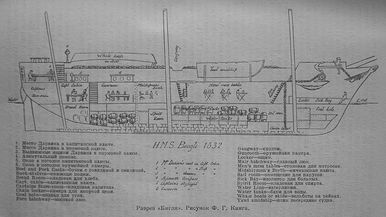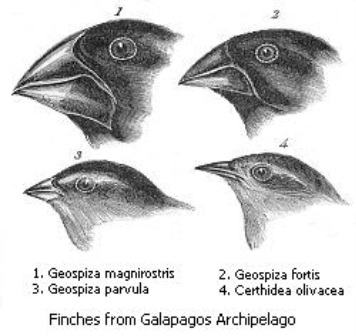A Great Voyage on the HMS Beagle
HMS Beagle

Image 6
In 1831 Darwin got the offer to be hired on the HMS Beagle as a naturalist. As Darwin was highly fascinated by Geology and by classifying plants and animals, he was certain that he wanted to be part of this expedition.
His father, however, did not share his son's enthusiasm. He marked his son's plans as nothing more but idle pursuits. Moreover, he was concerned about Charles' profession as a clergyman. Nevertheless, after hard work of persuasion, Robert Darwin finally agreed that Charles could join the HMS Beagle, which took off on December 27, 1831 to first visit places in South America.
For the route of the Beagle, check the map on the top of the page.
On the Beagle Darwin collected a great number of different insects and plants and he was fascinated by the great variety of species that existed. The young naturalist gathered all those different samples of organisms in various crates and sent this collection back to England so that they could be analyzed further by experts.
In 1833 Darwin began to do comparative studies between all the different fossils and the different species he had found and observed at all the different locations. The biologist even hired a servant who helped collecting the samples of different species so that Darwin himself had more time to actually observe and generate theories about what they found.
His father, however, did not share his son's enthusiasm. He marked his son's plans as nothing more but idle pursuits. Moreover, he was concerned about Charles' profession as a clergyman. Nevertheless, after hard work of persuasion, Robert Darwin finally agreed that Charles could join the HMS Beagle, which took off on December 27, 1831 to first visit places in South America.
For the route of the Beagle, check the map on the top of the page.
On the Beagle Darwin collected a great number of different insects and plants and he was fascinated by the great variety of species that existed. The young naturalist gathered all those different samples of organisms in various crates and sent this collection back to England so that they could be analyzed further by experts.
In 1833 Darwin began to do comparative studies between all the different fossils and the different species he had found and observed at all the different locations. The biologist even hired a servant who helped collecting the samples of different species so that Darwin himself had more time to actually observe and generate theories about what they found.

Image 7
On September 15, 1835 the Beagle arrived at the Galapagos Archipelago. Here Darwin made very important observations as well. Again he was highly impressed by the great variety of different species he came to see. Many people are probably familiar with the name of Galapagos Archipelago due to Darwin's discoveries of the so-called "Darwin Finches" which are split into many different species as they all differ concerning their shape of their beaks as one can clearly see on the picture on the right.
In January 1836 the Beagle arrived in Australia where Darwin could observe species he had never seen before. It was very important for the young scientist that he had the chance to visit so many different areas of the world as this strengthened his assumption that species vary all over the world and that no individual is equal to the other.
In May 1836 the ship even got to Africa, another area which displayed many species the crew of the Beagle had not been familiar with before.
On October 2, 1836 the Beagle finally arrived back in England after a long journey which lasted four years, nine months and five days. Now the next step was to analyze all the samples of fossils, plants, and animals that Darwin had collected during the expedition.
In January 1836 the Beagle arrived in Australia where Darwin could observe species he had never seen before. It was very important for the young scientist that he had the chance to visit so many different areas of the world as this strengthened his assumption that species vary all over the world and that no individual is equal to the other.
In May 1836 the ship even got to Africa, another area which displayed many species the crew of the Beagle had not been familiar with before.
On October 2, 1836 the Beagle finally arrived back in England after a long journey which lasted four years, nine months and five days. Now the next step was to analyze all the samples of fossils, plants, and animals that Darwin had collected during the expedition.
